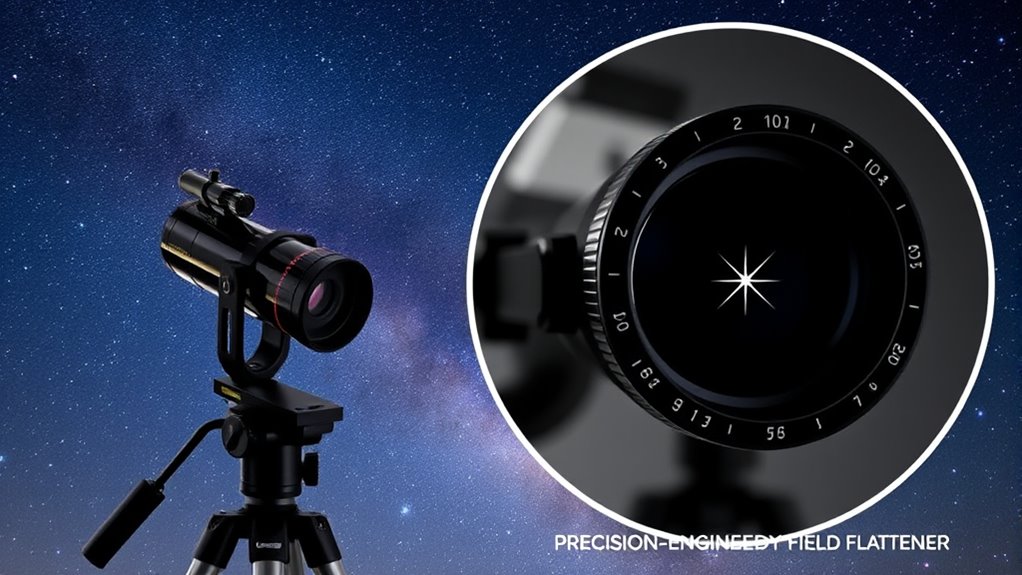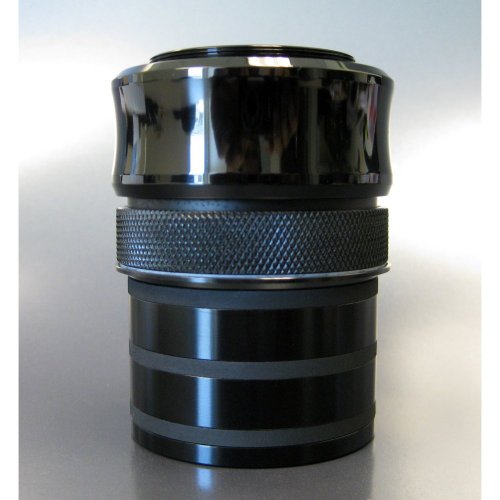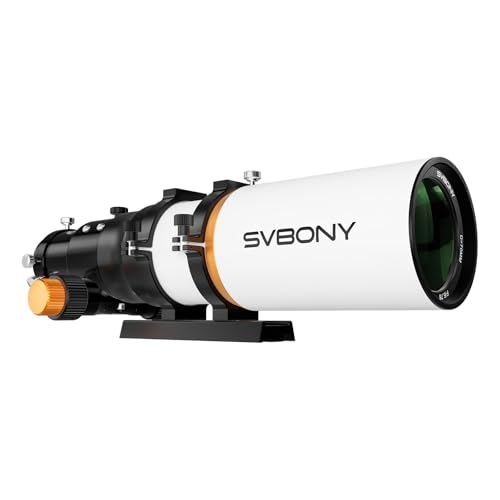If you’re looking to improve your astrophotography with refractor telescopes, I recommend exploring top field flatteners like the Explore Scientific Refractor Flattener, SVBONY models, and Sky-Watcher’s reducer-flattener. These precision devices correct field curvature, reduce aberrations, and deliver sharp, vibrant images across the entire frame. Compatibility with your telescope’s focal ratio and proper spacing are key for ideal results. Keep going, and you’ll discover more options to elevate your astrophotography experience!
Key Takeaways
- High-quality field flatteners correct field curvature, ensuring sharp, pin-point stars across the entire image for improved astrophotography.
- Compatibility with refractor telescopes from f/4 to f/8 and full-frame cameras maximizes image clarity and reduces distortions.
- Features ED glass and multi-coatings that minimize chromatic aberration and enhance contrast for vibrant, detailed images.
- Adjustable spacers and precise backfocus settings optimize flat-field correction and prevent vignetting.
- Lightweight, versatile designs with built-in rotators and filter cavities provide convenience for astrophotographers seeking top image quality.
Explore Scientific Refractor Telescope Field Flattener for Astrophotography
If you’re an astrophotographer aiming for sharp, distortion-free images, the Explore Scientific Refractor Telescope Field Flattener is an excellent choice. It reduces star distortion caused by field curvature, which makes stars look smeared away from the center. Designed specifically for refractors with focal ratios of f/5 to f/7, it enhances image quality of deep-sky objects like nebulae and galaxies. It’s easy to install, with a secure T-ring connection and a recommended 55mm spacing from the camera sensor. Fully multi-coated optical glass guarantees maximum light transmission and high contrast, delivering clearer, more detailed astrophotos every time.
Best For: astrophotographers using refractor telescopes with focal ratios between f/5 and f/7 seeking to improve image sharpness and reduce star distortion in their deep-sky astrophotography.
Pros:
- Effectively minimizes star distortion caused by field curvature, resulting in sharper images.
- Fully multi-coated optical glass enhances light transmission and contrast for high-quality astrophotos.
- Easy to install with a secure T-ring connection and precise 55mm spacing for optimal performance.
Cons:
- Designed specifically for telescopes with f/5 to f/7 focal ratios, limiting compatibility with other setups.
- Requires user-supplied T-rings for camera attachment, adding an extra step for some users.
- May necessitate precise spacing (55mm +/- 2mm) adjustments for optimal results, which could be challenging for beginners.
SVBONY SV193 Focal Reducer 2 Inch 0.8X Telescope Accessory
The SVBONY SV193 Focal Reducer 2 Inch 0.8X is an excellent choice for astrophotographers using refractor telescopes like the SV503 80mm F7 ED, especially those aiming to capture wide-field images with minimal vignetting. It supports full-frame cameras, with a 2-inch front socket and M48 threading for easy attachment. This focal reducer shortens the focal length by 20%, expanding the field of view and reducing exposure times, making it ideal for capturing large objects like star clusters. It also improves image flatness, especially with small sensors, and accepts 2-inch filters, enhancing overall imaging capabilities.
Best For: astrophotographers using refractor telescopes who want to expand their field of view and reduce exposure times for wide-field imaging.
Pros:
- Supports full-frame cameras and accepts 2-inch filters, enhancing versatility.
- Reduces focal length by 20%, enabling wider fields and faster imaging sessions.
- Improves image flatness and star point sharpness across the frame, especially with small sensors.
Cons:
- Some units may experience coating flaws, optical issues, or damage during shipping.
- Slight star distortion or egg-shaped stars can occur, requiring post-processing correction.
- Quality control inconsistencies may lead to variability in performance and customer satisfaction.
SVBONY SV209 Field Flattener, 0.8X Focal Reducer for Telescopes
Looking for a reliable field flattener that guarantees sharp, distortion-free images across your entire frame? The SVBONY SV209 Field Flattener, 0.8X focal reducer, is designed specifically for the SV550 122mm f/7 APO refractor. It converts 854mm focal length to 683.2mm (f/5.6), enabling faster, wider-field imaging. Compatible with DSLR and CCD cameras, it ensures sharp focus from edge to edge. It features a sturdy 63x1mm threaded connection for easy setup. Customers praise its build quality and effectiveness in flattening the field, though some report minor focus adjustments are needed. Overall, it’s a solid choice for astrophotographers seeking improved image quality.
Best For: astrophotographers and terrestrial observers using the SV550 122mm f/7 APO refractor seeking to achieve sharp, wide-field images with minimal distortion.
Pros:
- Provides flat, sharp images across the entire frame, including corners
- Compatible with DSLR and CCD cameras for versatile imaging options
- Easy to install with a sturdy 63x1mm threaded connection
Cons:
- Some users may need to fine-tune backspacing and extension tube adjustments for optimal focus
- Minor issues reported with coating quality on a few units
- Slightly larger and heavier than standard accessories, requiring stable mounting
HOTECH SCA 2 Inch Field Flattener for Refractor Telescopes
The HOTECH SCA 2 Inch Field Flattener is an excellent choice for astrophotographers seeking sharp, distortion-free images across their entire telescope field. Its fully multi-coated two-element lens maximizes light transmission, ensuring bright, clear images. Compatible with f/5 to f/8 refractors, it delivers consistent sharpness from edge to edge. The built-in 2” filter thread and T-ring compatibility make it easy to attach various cameras. The center-loading SCA T-Adapter secures the camera precisely, minimizing alignment issues. Designed for ease of use and high-quality results, this flatener is a reliable tool for capturing stunning astrophotos with refractor telescopes.
Best For: astrophotographers using refractor telescopes seeking to capture sharp, distortion-free images across their entire field.
Pros:
- Fully multi-coated two-element lens maximizes light transmission for bright, clear images
- Compatible with f/5 to f/8 refractor telescopes, ensuring versatile use
- Built-in 2” filter thread and T-ring compatibility simplify camera attachment
Cons:
- May require careful alignment to ensure optimal performance
- Limited to telescopes within the specified focal ratio range (f/5 to f/8)
- Price variation could affect affordability for some users
SVBONY Focal Reducer for SV503 Telescope
If you’re aiming to capture wide-field astrophotography with your SV503 102mm ED refractor, the SVBONY Focal Reducer is an excellent choice because it offers a 0.8x focal reduction that broadens your sky view. It enhances image quality by providing wider star fields, finer star points, and an improved signal-to-noise ratio. Designed with multi-coated optics and a durable aluminum body, it’s built to last while remaining lightweight. With standard filter threads and a compatible rear connection, it easily integrates into your setup. This reducer not only simplifies focusing but also enables stunning full-frame images, making it a reliable tool for high-quality astrophotography.
Best For: astrophotographers using the SV503 102mm ED refractor seeking to capture wide-field, high-quality celestial images with ease.
Pros:
- Provides a 0.8x focal reduction to enhance wide-field imaging and star field coverage
- Built with multi-coated optics and durable aluminum body for reliable, high-quality performance
- Compatible with standard filter threads and camera connections for versatile setup integration
Cons:
- May require additional adapters for certain camera or accessory configurations
- Slight reduction in focal length might not suit those needing higher magnification
- Designed specifically for SV503 telescopes, limiting universal compatibility
SVBONY SV503 Refractor Telescope with Built-in Field Flattener
Novice and amateur astronomers seeking crisp, distortion-free images will appreciate the SVBONY SV503 Refractor Telescope’s built-in field flattener. With its F/6.78 ratio and 70mm aperture, it delivers bright, sharp views of galaxies, nebulae, and star clusters. The ED glass reduces chromatic aberration, ensuring true-to-life colors. The integrated field flattener corrects field curvature, giving a flat, wide image free from edge distortions—perfect for astrophotography and visual use. Its self-flat-field design means no extra accessories are needed for *ideal* images, making setup straightforward. Combined with the dual-speed focuser and stable mount, it’s a versatile choice for quality celestial observations.
Best For: amateur astronomers and astrophotographers seeking high-quality, distortion-free images of celestial objects with minimal setup.
Pros:
- Built-in field flattener provides a wide, flat image plane, ideal for astrophotography and visual observation.
- ED glass reduces chromatic aberration, ensuring sharp, true-to-life images with vibrant colors.
- Dual-speed focuser allows precise and quick focus adjustments for detailed viewing and imaging.
Cons:
- Designed primarily for adult users, may not be suitable for children or complete beginners without guidance.
- Limited aperture size (70mm), which may restrict deep-sky object visibility compared to larger telescopes.
- Requires stable mounting support; less effective on unstable or shaky mounts during high-magnification viewing.
Astromania 2 Field Flattener for Astronomy Photos
Astromania’s 2 Field Flattener is an excellent choice for astrophotographers seeking sharp, flat images across their entire field of view. It’s compatible with refractor telescopes having focal ratios from f4 to f8 and features M48 threading for full aperture illumination at 2 inches. The flattener corrects field curvature, ensuring pinpoint stars even at the edges, thanks to its high-quality multi-coated lenses. Weighing just 8.8 ounces, it’s lightweight and portable, making setup easy without adding bulk. With a versatile back focus of -109mm, it offers flexible configurations. This device is perfect for capturing crisp, professional-looking astrophotos with minimal hassle.
Best For: amateur and professional astrophotographers seeking sharp, flat images across their entire refractor telescope’s field of view.
Pros:
- Corrects field curvature for pinpoint stars at the edges, ensuring high-quality astrophotos.
- Compatible with refractor telescopes from f4 to f8 and features full aperture illumination with M48 threading.
- Lightweight (8.8 ounces) and portable, making setup easy and unobtrusive.
Cons:
- Designed specifically for refractor telescopes; not suitable for other types like reflectors or compound telescopes.
- Back focus adjustment range may require additional accessories for certain setups.
- As a specialized optical device, it may be more expensive compared to basic adapters or extension tubes.
SVBONY SV503 Refractor Telescope, 102mm F7
The SVBONY SV503 Refractor Telescope, with its 102mm aperture and F7 focal ratio, is an excellent choice for astrophotographers seeking sharp, flat images across the entire field of view. Its doublet air-spaced achromatic S-FPL51 ED lens reduces chromatic aberration, ensuring vibrant, accurate colors. The fully multi-coated optics maximize light transmission, boosting brightness and contrast. The dual-speed rack and pinion focuser allows precise adjustments, while the 360° field rotator makes framing easy. With a 133mm retractable lens hood and compatible accessories, the SV503 offers versatility, making it ideal for both deep-sky photography and terrestrial observation.
Best For: Amateur astronomers and astrophotographers seeking a versatile, high-quality refractor for both planetary and deep-sky imaging.
Pros:
- High-quality 102mm aperture with F7 focal ratio for sharp, detailed images across the entire field of view
- Fully multi-coated optics and ED glass lens to reduce chromatic aberration and enhance brightness and contrast
- Dual-speed rack and pinion focuser with 360° field rotator for precise focusing and easy framing
Cons:
- Slightly bulkier design due to included accessories like the lens hood and mount components
- May require additional adapters or mounts for specific camera or accessory compatibility
- Not ideal for very long-exposure astrophotography without additional mounting or tracking equipment
SVBONY SV193 Focal Reducer 2 Inch 0.8X for Telescope Camera
If you’re looking to expand your astrophotography capabilities, the SVBONY SV193 Focal Reducer 2 Inch 0.8X is an excellent choice for refractor telescope users who want a wider field of view and sharper images across the entire sensor. Designed for full-frame cameras like the SV305C Pro and IMX662 planetary camera, it reduces focal length by 0.8X, providing a flatter image plane and minimizing star distortion at the edges. Its standard 2-inch front socket and M48x0.75 threading make it easy to connect. This focal reducer is perfect for capturing detailed celestial images with consistent illumination, especially when working with advanced refractors like the SV503 80ED.
Best For: amateur and professional astronomers seeking to enhance their astrophotography with wider, sharper images on full-frame sensors using refractor telescopes.
Pros:
- Reduces focal length by 0.8X for a wider field of view and flatter image plane.
- Compatible with full-frame cameras such as SV305C Pro and IMX662 planetary cameras.
- Easy to connect via standard 2-inch front socket and M48x0.75 threading, ensuring versatile setup options.
Cons:
- Designed specifically for refractor telescopes, limiting use with other telescope types.
- May require additional accessories for optimal compatibility with certain camera models.
- Slightly increased complexity in setup for those unfamiliar with focal reducers and threading connections.
SVBONY SV503 Portable Telescope Tube
The SVBONY SV503 Portable Telescope Tube stands out as an excellent choice for anyone interested in astrophotography or detailed visual observation, thanks to its high-quality optical design and sturdy construction. It features an S-FPL51 ED glass objective, virtually eliminating chromatic aberration, and produces sharp, high-contrast images suitable for planets, lunar features, nebulae, and galaxies. Its robust build includes an anodized finish, retractable dew shield, and a smooth 2-inch focuser supporting heavy accessories. Compact and portable, it’s ideal for travel, offering precise focus adjustments and compatibility with focal reducers. Overall, the SV503 combines reliable performance with excellent value, making it a versatile tool for amateur astronomers.
Best For: amateur astronomers and astrophotographers seeking a portable, high-quality refractor telescope for detailed planetary, lunar, and deep-sky observation.
Pros:
- Excellent optical performance with virtually no chromatic aberration due to S-FPL51 ED glass
- Robust build quality with smooth, precise focuser and sturdy tube rings
- Compact and portable design ideal for travel and mobile observing sessions
Cons:
- May require upgrades like a flat-field reducer for optimal astrophotography
- Slight halos around very bright stars can be reduced with post-processing
- Limited field of view without focal reducers, which can restrict large object imaging
Astromania 2 Field Flattener for Astronomy Photos
Astromania’s 2 Field Flattener is an excellent choice for astrophotographers using refractor telescopes with focal ratios from f/4 to f/8. It corrects field curvature, delivering sharp stars across the entire image, making it ideal for astrophotography. The flattener features M48 threading for full aperture illumination at 2 inches and 109mm back focus for accessories. Its high-quality, multi-coated lenses reduce reflections and enhance clarity. Compact and lightweight at just over six ounces, it’s easy to handle. While setup can be challenging without proper guidance, many users achieve excellent flat-field images after consulting support, making this a versatile tool for quality astrophotos.
Best For: astrophotographers using refractor telescopes with focal ratios from f/4 to f/8 seeking to achieve flat, sharp images across the entire field.
Pros:
- Corrects field curvature for sharp star images from center to edge
- High-quality multi-coated lenses reduce reflections and improve clarity
- Compact and lightweight design for easy handling and setup
Cons:
- Setup can be challenging without proper guidance or instructions
- Customer support experiences vary, with some users reporting difficulties
- Moderate user ratings suggest some may experience issues or limitations
SVBONY SV260 2 Telescope Filter for SV503 Refractor Telescope
Designed to enhance imaging quality in refractor telescopes, the SVBONY SV260 2 Telescope Filter is ideal for astronomers seeking sharper, more vibrant views of deep-sky objects. It’s a 5-bandpass broadband filter with OD4 cut-off depth, providing over 90% peak transmittance. This filter effectively isolates light pollution, reducing unwanted glare and improving contrast. Its multi-bandpass design restores celestial colors accurately, resulting in richer, more detailed images. When paired with the SV503 refractor telescope, it enhances both observation and astrophotography, delivering clearer, more colorful views of galaxies, nebulae, and star clusters while minimizing edge blur thanks to its integrated flat-field features.
Best For: amateur and advanced astronomers seeking to improve deep-sky imaging and observation clarity with their SV503 refractor telescope.
Pros:
- High over 90% peak transmittance for bright, sharp images
- Effectively reduces light pollution with OD4 cut-off, enhancing contrast
- Multi-bandpass design restores celestial colors with rich, detailed hues
Cons:
- May require additional equipment or accessories for optimal use
- The filter’s effectiveness depends on proper alignment and handling
- Limited to use with compatible SV503 refractor telescopes, restricting versatility
SVBONY SV503 Refractor Telescope with Field Flattener and SV305C Camera
If you’re aiming for sharp, distortion-free images across the entire field of view, the SVBONY SV503 Refractor Telescope with its built-in field flattener is an excellent choice. Its flat-field design minimizes chromatic aberration, ensuring true-to-life colors and edge-to-edge clarity. The 70mm aperture and F/6.78 focal ratio deliver bright, detailed views of galaxies, nebulae, and star clusters. Paired with the SV305C camera, which features a sensitive IMX662 sensor and ultra-low noise, you get crisp, high-quality images even in low-light conditions. This combination is perfect for both planetary and deep-sky imaging, offering precision and minimal distortion.
Best For: amateur and experienced astronomers seeking high-precision, distortion-free planetary and deep-sky imaging with minimal chromatic aberration.
Pros:
- Built-in field flattener eliminates edge distortion for a flat, wide viewing field.
- ED glass optics reduce chromatic aberration, ensuring true-to-life colors.
- High sensitivity and ultra-low noise camera capture clear images even in low-light conditions.
Cons:
- The 70mm aperture may limit brightness compared to larger telescopes.
- F/6.78 focal ratio requires precise focusing for optimal image quality.
- The system may require additional accessories for advanced astrophotography setups.
Sky-Watcher Evolux 62ED Reducer/Flattener (0.9X)
The Sky-Watcher Evolux 62ED Reducer/Flattener (0.9X) is an excellent choice for astrophotographers seeking sharp, flat-field images with their refractor telescopes. Its 62mm aperture and f/5.8 focal ratio deliver a 360mm focal length, ideal for wide-field astrophotography. The device includes an ED element that enhances image quality, reducing aberrations. With a 55mm back focus and built-in rotator, it simplifies filter use and framing. Compatible with M56x1 female or M48 male threads, it’s versatile and easy to install. Compact and lightweight, it’s perfect for those wanting to improve image quality without adding bulk to their setup.
Best For: astrophotographers seeking sharp, flat-field images with their refractor telescopes, especially for wide-field astrophotography using compact and lightweight equipment.
Pros:
- Includes an ED element to reduce aberrations and improve image quality
- Compact, lightweight design ideal for portable setups
- Built-in rotator with filter cavity simplifies framing and filter use during imaging
Cons:
- Limited to telescopes with M56x1 female or M48 male threads, reducing compatibility with some models
- May require additional adapters for use with non-compatible mounts or accessories
- Focal length reduction to 324.4mm (from 360mm) may not suit all photography needs
SVBONY SV220 Dual-Band Nebula Filter with SV503 70mm Refractor Telescope
Astrophotographers seeking to capture detailed images of emission nebulae, planetary nebulae, or supernova remnants will find the SVBONY SV220 Dual-Band Nebula Filter paired with the SV503 70mm refractor telescope an excellent combination. The filter enhances contrast by reducing moonlight and light pollution, revealing finer details without increasing nebula brightness. The SV503’s flat-field design and built-in field flattener ensure sharp, distortion-free images across the entire field of view. Together, they deliver bright, true-to-life colors and high contrast, making this pairing ideal for deep-sky imaging of gaseous objects under various sky conditions.
Best For: astrophotographers and stargazing enthusiasts aiming to capture detailed images of emission nebulae, planetary nebulae, and supernova remnants with enhanced contrast and true-to-life colors.
Pros:
- Enhances contrast and detail by reducing light pollution and moonlight interference.
- Compatible with SV503 70mm refractor telescope, offering sharp, flat-field images.
- Improves image clarity and color accuracy for deep-sky astrophotography.
Cons:
- Designed specifically for use with the SV503 70mm telescope; limited compatibility with other models.
- May require additional accessories or adapters for different telescopes.
- Effectiveness can be reduced under extremely light-polluted skies or adverse weather conditions.
Factors to Consider When Choosing Field Flatteners for Refractor Telescopes

When selecting a field flattener, I consider how well it matches my telescope’s focal ratio and optical quality to guarantee sharp images across the field. I also look at its backfocus requirements, mounting options, and how effectively it maintains flatness at the edges. These factors help me choose a flattener that fits my setup and delivers ideal performance.
Compatibility With Focal Ratios
Choosing a field flattener that matches your refractor’s focal ratio is vital for sharp, distortion-free images. Most flatteners are rated for focal ratios between f/5 and f/7, which covers the typical range for many refractors. Using a flattener outside this range can cause star distortion, vignetting, or reduced sharpness. Some flatteners are adjustable or designed for specific focal ratios, so it’s important to verify compatibility before buying. If the focal ratio of your telescope is considerably faster or slower than the flattener’s recommended range, image quality may suffer, with star elongation or uneven illumination. Proper spacing, often specified in millimeters, is also critical to ensure your telescope’s focal ratio and optical correction align correctly, delivering ideal results.
Optical Coatings and Quality
Optical coatings and glass quality play a significant role in guaranteeing your field flattener delivers sharp, vibrant images. High-quality coatings, like fully multi-coated or multi-layer options, boost light transmission and minimize reflections, resulting in brighter, clearer images. Proper application of these coatings guarantees minimal light loss across the visible spectrum, which is vital for accurate color reproduction and high contrast in astrophotography. The quality of the optical glass itself—low dispersion and high homogeneity—directly affects image sharpness and the effectiveness of flattening corrections. Durable coatings resistant to scratches, dust, and moisture help maintain optical performance over time. Assuring coatings are evenly applied and free of defects is essential to prevent optical aberrations like star elongation or chromatic distortions at the edges of your field.
Backfocus and Spacing
Achieving sharp, distortion-free images with a refractor telescope hinges on maintaining the correct backfocus distance between the field flattener and the camera sensor. Typically, this distance is around 55mm, but it’s vital to follow the manufacturer’s specifications. Proper spacing prevents vignetting, star elongation, and edge distortion, ensuring the entire image remains sharp. Small variations, whether from spacers or adapters, can greatly impact image quality and focus accuracy. If the backfocus is too short or too long, the optical correction offered by the flattener is compromised, leading to subpar results. Consistently maintaining the recommended backfocus ensures the flat field correction aligns perfectly with the telescope’s optical design, delivering flatter, sharper images across the entire sensor. Proper backfocus adjustment is essential for ideal astrophotography.
Mounting and Attachment
Selecting the right field flattener involves guaranteeing it has compatible mounting threads or connection types that match your telescope’s focuser or visual back, such as M48, 2-inch, or T-thread. A secure and stable attachment is vital to prevent shifts or misalignments during imaging or observation. Check that the mounting system allows precise centering of your camera or eyepiece along the optical axis to minimize edge distortions. It’s also important to verify recommended back focus distances and spacers to achieve ideal spacing between the flattener and the sensor. Some flatteners feature adjustable or multiple attachment points, accommodating different telescope models and accessories. Proper mounting and attachment ensure your setup remains stable, consistent, and aligned, leading to sharper, more accurate images.
Field Flatness Performance
When evaluating a field flattener’s performance, I focus on how well it corrects field curvature so stars stay sharp across the entire image. The key is achieving ideal flatness, where the image plane remains flat with minimal star elongation or distortion at the edges. This depends heavily on the flattener’s optical design, including lens elements and coatings that reduce aberrations. Proper backspacing and distance from the camera sensor are vital; even slight misalignments can cause uneven focus and distortions. Additionally, the flatener’s compatibility with your telescope’s focal ratio, such as f/5 to f/7, influences its ability to produce distortion-free images. A high-performing flatener ensures consistent sharpness from center to edges, enhancing overall image quality.
Build Durability and Support
Building a durable field flattener is essential for ensuring consistent performance over time, especially since it will face regular handling and environmental exposure. High-quality, fully multi-coated optical glass combined with sturdy metal housings provides the necessary resilience against everyday use and outdoor conditions. Support services like manufacturer warranties, responsive customer assistance, and detailed setup guides are crucial for troubleshooting installation issues and maintaining long-term functionality. The choice of materials and build quality directly affects the flatener’s resistance to damage, optical stability, and lifespan. Reliable support helps with optical alignment and backspacing adjustments, which are vital for optimal image flatness. Well-supported flatteners, with clear documentation and technical help, reduce user error and boost confidence in your setup.
Frequently Asked Questions
How Do Field Flatteners Impact Image Brightness?
Field flatteners generally don’t affect image brightness considerably. I’ve noticed that while they improve the flatness of the field, they might slightly reduce brightness at the edges because of added glass elements. However, the overall gain in image clarity and sharpness outweighs this minor dimming. If I want brighter images, I use proper exposure settings or increase ISO rather than worry too much about brightness loss from the flattener.
Are Field Flatteners Compatible With All Refractor Telescopes?
Are field flatteners compatible with all refractor telescopes? Well, if your refractor is a standard model, chances are good. But if you own a vintage or highly specialized scope, you might need a custom solution. I’ve found that checking your telescope’s specifications and consulting with manufacturers saves a lot of frustration. Ultimately, most modern refractors play nice with field flatteners, making your astrophotography smoother and more spectacular.
What Is the Typical Cost Range for Quality Field Flatteners?
The typical cost for quality field flatteners ranges from $150 to $500. I’ve found that investing within this range usually gets you reliable build quality and effective image correction. Of course, higher-end models offer better optical performance and durability, but you can definitely find good options at the lower end. It’s worth considering your specific telescope size and imaging needs to choose the best value.
How Do I Align a Field Flattener Properly?
To align a field flattener properly, I first attach it securely to my telescope’s focuser. Then, I insert my camera or eyepiece, ensuring everything is tight and centered. Next, I focus on a star, adjusting the flattener’s position slightly until the star images are sharp and uniform across the frame. I verify the alignment by capturing test images, tweaking as needed until the edges match the center in clarity and focus.
Do Field Flatteners Affect Exposure Times in Astrophotography?
Field flatteners don’t directly affect your exposure times, but they do improve image quality across your field of view. With flatter images, you won’t need to take extra exposures to fix edge distortions or vignetting later. This means I can often reduce my total exposure time, saving time and effort. So, while they don’t change how long I expose, they help me get cleaner images faster.
Conclusion
Choosing the right field flattener can transform your astrophotography, sharpening your images and reducing distortions. Whether you prioritize compatibility, focal length, or image quality, finding the perfect fit makes all the difference. By considering your specific needs and equipment, you’ll enjoy clearer stars, crisper details, and more stunning shots. Invest in the right field flattener, and watch your astronomical images reach new heights, heighten your passion, and deepen your appreciation for the cosmos.

























